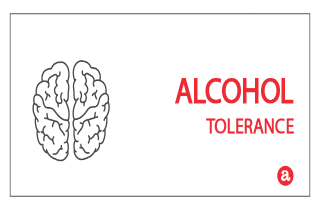Alcohol consumption interferes with many bodily functions and affects behavior. One such function is the development of tolerance.
So, when exactly do drinkers become tolerant to alcohol? Chronic alcohol consumption can bring on the development of tolerance to at least some of alcohol’s effects. What are symptoms of developing tolerance and is it possible to lower your alcohol tolerance? We explore here. And invite your questions about drinking alcohol, becoming dependent on alcohol, or getting help for addiction to alcohol at the end.
Developing tolerance to alcohol
First, what is tolerance to alcohol?
If you are tolerant to alcohol, it means that after continued drinking, consumption of a specific amount of alcohol produces a lesser effect than when you first starting drinking. The term “tolerance” refers to a decrease in brain sensitivity to alcohol following long-term exposure. In essence, during tolerance, there is reduction in the intensity of the effect of alcohol (or other drugs) over the course of repeated use. It also means that increased amounts of alcohol are necessary to produce the same original effect. Thus, a person developing tolerance to alcohol must drink greater quantities of alcoholic beverages to produce the same effect that had been previously achieved at a lower consumption level.
So who develops tolerance to alcohol? Developing tolerance to alcohol differs by individual. Humans develop tolerance when their brain functions adapt to compensate for the disruption caused by alcohol in both their behavior and their bodily functions. This adaptation is called functional tolerance.
Frequently, chronic heavy drinkers display functional tolerance when they show few obvious signs of intoxication even at high blood alcohol concentrations, which in others would be incapacitating or even fatal. Because the drinker does not experience significant behavioral impairment as a result of drinking, tolerance may facilitate the consumption of increasing amounts of alcohol. This can result in a physical addiction to drinking and alcohol-related organ damage.
Alcohol tolerance symptoms
Similar symptoms occur in people who are alcohol-tolerant. Alcohol causes neurons (nerve cells) in the central nervous system to adapt to its presence. Those who are tolerant require more alcohol to produce an effect, such as reducing anxiety. In addition, liver enzymes that detoxify alcohol increase with frequent drinking; thus, the liver of an alcoholic break down alcohol more quickly than it did when first exposed to alcohol, contributing to the development of tolerance.
One reaction to the lack of tolerance is dysphoria, or a disturbed mood, nausea, headache, maybe vomiting and general ill feeling that only gets worse with alcohol. The nonalcoholic actually feels better as the alcohol leaves the body so there appears to be little reinforcement to drink more alcohol. The alcoholic, on the other hand, feels better as the blood-alcohol level rises in the body and brain so that the motivation is to drink more.
Alcohol tolerance: How long?
The amount of time that it takes to become tolerant to alcohol differs by person. Generally, long-term exposure to alcohol can lead to tolerance of its effects and eventually to physical dependence. If alcohol-dependent individuals stop drinking, they experience withdrawal symptoms, which may include tremors, anxiety, sweating, hallucinations, and seizures. The site of action of all these effects is the brain.
High tolerance to alcohol
A person who can drink large quantities of alcohol without feeling its “normal” effects may have developed a high tolerance to alcohol. Tolerance comes from chronic use of alcohol that results in physical and mental adaptation to its presence in the body. The development of tolerance is shown by an increase in the amount of alcohol required to produce the desired effects and can indicate the onset of physical dependence. Higher tolerance can lead to yet more drinking – and the more we drink, the more damage it can cause to mental and physical health.
How to lower tolerance to alcohol
The good news about tolerance is that you can decrease it (and the associated health risks) fairly easily. Tolerance can be reversed gradually through either moderating the quantity and frequency of your drinking, or taking a break from alcohol for a few weeks.
Building up tolerance to alcohol questions
Do you have questions about building up tolerance to alcohol? Please let us know if you still have questions about tolerance to alcohol. If you want to know more, contact us in the comments section below. We will be happy to help and try to respond to all legitimate concerns personally and promptly.









Related Posts